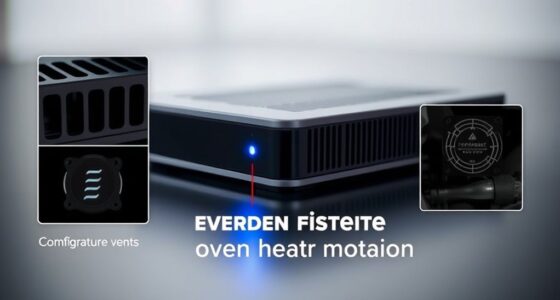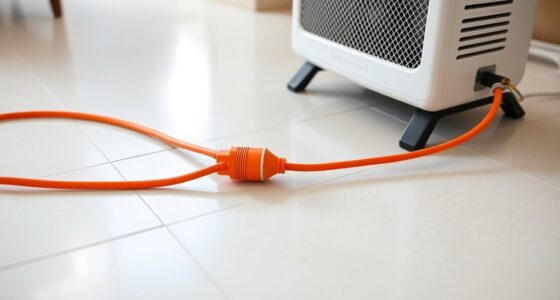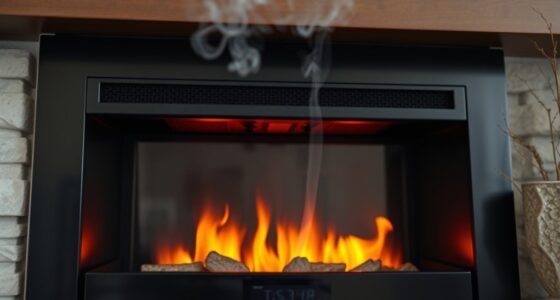Many believe that tip over and overheat sensor codes are just false alarms or minor issues, but they actually signal important safety or operational problems. Proper calibration, installation, and maintenance are key to avoiding unnecessary shutdowns or risks. Compliance with standards ensures your sensors work accurately and reliably, helping you prevent hazards and legal issues. Understanding these codes and their correct responses is vital—if you want to guarantee safety and stay compliant, keep exploring how to manage them effectively.
Key Takeaways
- Sensor codes signal specific safety issues like tipping or overheating, not just false alarms or generic warnings.
- Proper calibration and installation prevent false triggers and ensure accurate hazard detection.
- Safety codes activate alarms, signals, or shutdowns to protect users and equipment effectively.
- Routine maintenance, calibration, and cleaning are essential to prevent false alarms and maintain sensor accuracy.
- Understanding safety-critical codes versus informational ones helps prioritize proper responses and regulatory compliance.
Common Misconceptions About Sensor Codes

Many people believe that sensor codes for tip-over and overheat sensors are simply generic warnings, but in reality, they often indicate specific issues that require careful attention. One common misconception is that false alarms are frequent and unavoidable. However, proper sensor calibration can profoundly reduce false alarms and improve accuracy. When sensors are not correctly calibrated, they might trigger unnecessary warnings, leading you to believe there’s a problem when there isn’t one. This can cause unnecessary shutdowns or delays. Understanding how calibration works helps you distinguish between real issues and false alarms, ensuring smoother operation. Recognizing that sensor codes are precise indicators, not just generic alerts, allows you to address issues more effectively and maintain compliance with safety standards. Additionally, understanding the importance of proper installation and maintenance can further prevent false alarms and ensure reliable operation.
Understanding the Meaning Behind Tip Over and Overheat Codes
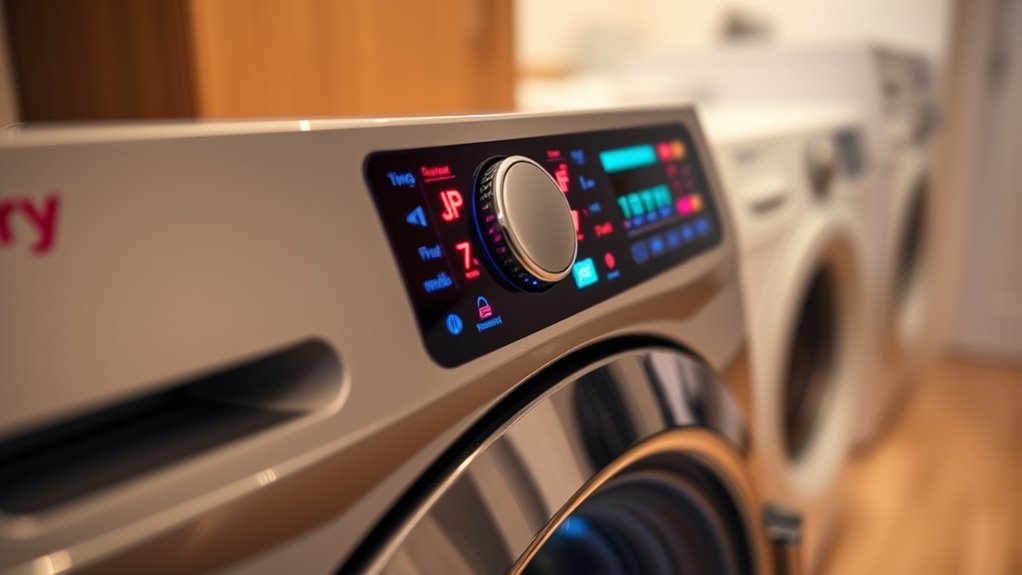
When a tip over or overheat code appears, it’s important to comprehend what caused it and what it signifies for your safety system. You’ll learn how these codes are triggered, how the safety features work to protect you, and the steps to troubleshoot and resolve the issue. This understanding helps you respond quickly and ensure your equipment stays safe and compliant. Additionally, knowing the specific sensor codes can aid in diagnosing the problem more accurately.
Code Triggers Explained
Understanding what triggers tip over and overheat sensor codes is vital for diagnosing appliance issues accurately. These codes activate when sensors detect unsafe conditions, such as the appliance tipping or overheating. Proper sensor placement is essential; if sensors are incorrectly installed or shifted from their calibration procedures, false triggers can occur. For example, a misaligned tip sensor might think the appliance tips and trigger a shutdown. Overheat sensors rely on accurate calibration to monitor temperature precisely; if calibration is off, the sensor may signal a fault even when temperatures are safe. Regularly checking sensor placement and following calibration procedures helps guarantee the sensors respond correctly. Additionally, sound healing science suggests that vibrations can influence cellular health, which underscores the importance of precise sensor calibration for maintaining appliance safety. Knowing these trigger mechanisms allows you to avoid unnecessary repairs and maintain appliance safety effectively.
Safety System Functions
Knowing what tip over and overheat codes mean helps you respond quickly and safely to appliance issues. These safety system functions are designed to protect both users and the appliance by detecting abnormal conditions. Proper sensor calibration ensures that sensors accurately identify tipping or overheating, reducing false alarms and ensuring timely responses. When a code triggers, the system often integrates alarms that alert you immediately, prompting action before damage occurs. This alarm integration can include visual indicators, sounds, or even automatic shutdowns to prevent hazards. Understanding these functions helps you appreciate how the safety system works behind the scenes, emphasizing their importance in maintaining appliance safety and compliance. Accurate calibration and effective alarm integration are essential for reliable performance and peace of mind. Speaks 4 Me Online offers additional training and resources to improve your understanding of these safety features.
Troubleshooting Steps
Interpreting tip over and overheat codes is key to troubleshooting appliance issues effectively. First, check if the sensors require calibration; improper calibration can trigger false alarms. Follow the manufacturer’s instructions to perform sensor calibration, ensuring accurate readings. Next, review the code troubleshooting steps specific to your appliance model—this might involve resetting the sensors or inspecting for physical damage. If a code persists, examine the sensor wiring and connections for loose or damaged parts. Clearing the code after calibration or repairs helps confirm if the issue is resolved. Remember, persistent codes often indicate underlying problems like faulty sensors or control boards, so don’t ignore ongoing issues. Proper troubleshooting helps prevent unnecessary replacements and ensures your appliance operates safely and efficiently. Additionally, understanding asset division laws can help in managing appliance ownership and warranties during disputes.
How Regulatory Standards Influence Sensor Requirements

Regulatory standards directly shape how sensors are designed, tested, and certified to guarantee safety and reliability. You need to understand these requirements because they determine whether your products meet legal compliance. By aligning with regulations, you can avoid costly recalls and ensure your sensors are trusted in the market. Additionally, understanding nutritional advantages of green juice can inform broader standards related to health and safety testing for related products.
Regulatory Impact on Design
Regulatory standards play a critical role in shaping sensor design by setting clear safety and performance benchmarks that manufacturers must meet. These standards influence how sensors are calibrated to guarantee consistent accuracy and reliability across production batches. They also dictate manufacturing standards, requiring components and assembly processes to adhere to strict quality controls. As a result, designers must incorporate features that enable easy calibration and maintain sensor integrity over time. Regulatory requirements push you to develop sensors that withstand environmental factors and prevent false alarms, ensuring safety without compromising functionality. By aligning design choices with these standards, you not only ensure compliance but also build trust with consumers who rely on your sensors for safety-critical applications. Additionally, understanding the impact of standards on sensor durability helps in creating products that are both compliant and long-lasting.
Certification and Compliance Standards
Certification and compliance standards directly shape the requirements your sensors must meet to be market-ready. These standards guarantee your sensors undergo rigorous certification testing, validating their safety and reliability. Sensor calibration is a key part of this process, guaranteeing accurate performance across various conditions. Regulatory bodies specify calibration procedures to maintain consistency and precision. Certification testing verifies that sensors meet safety thresholds, durability, and environmental resilience. Adhering to these standards isn’t optional; it’s essential for market approval and customer trust. By understanding and implementing the necessary certification and compliance protocols, you ensure your tip-over and overheat sensors not only meet legal requirements but also deliver dependable performance, reducing recalls and liability risks. Ultimately, compliance standards help you produce safer, more reliable sensors that stand out in a competitive market. Compliance processes ensure consistent quality and foster consumer confidence in your products.
The Role of Safety in Sensor Code Compliance

Safety is the primary reason sensors like tip-over and overheat detectors are integrated into equipment, ensuring that potential hazards are identified before they cause harm. These sensors play a crucial role in maintaining fire safety by detecting abnormal temperature rises or unstable positioning early. When sensor reliability is prioritized, you can trust that alerts are accurate and timely, reducing the risk of accidents or fires. Compliance with safety codes emphasizes the importance of these sensors working correctly and consistently. By adhering to standards, manufacturers help prevent dangerous situations, protect users, and promote confidence in the equipment’s safety features. Additionally, sound design principles can be applied to enhance alert signals, making them more noticeable without causing unnecessary alarm. Ultimately, safety in sensor code compliance isn’t just about meeting regulations — it’s about safeguarding lives and property through effective, reliable detection.
Differentiating Between Critical Safety Alerts and Informational Codes
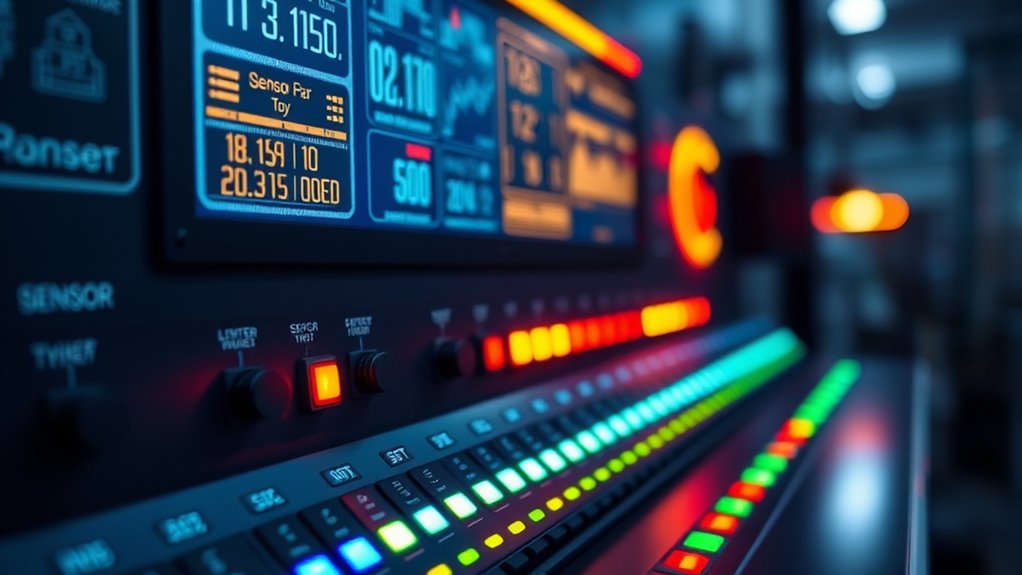
Understanding the difference between critical safety alerts and informational codes is essential for proper equipment monitoring. Critical alerts indicate immediate hazards, such as tip-over or overheat conditions, requiring prompt action and often triggering safety shutoffs. Informational codes, on the other hand, provide data about the sensor’s status, like sensor calibration needs or maintenance schedules, which don’t pose immediate danger but are important for ongoing safety and performance. Recognizing these distinctions helps you prioritize responses effectively. Always review code descriptions carefully, and don’t overlook informational messages—they can prevent future issues. Properly maintaining sensors through regular calibration ensures alerts are accurate and reliable, reducing false alarms. Color accuracy and contrast ratio are also key factors that influence the safety and proper functioning of projectors and related equipment. Differentiating these codes ensures safety protocols are followed without unnecessary disruptions, keeping equipment safe and compliant.
Practical Steps for Ensuring Proper Sensor Functionality

To keep sensors functioning correctly and avoid false alarms or missed alerts, you should implement practical maintenance routines. Regularly perform sensor calibration to guarantee accuracy, especially after any physical impacts or environmental changes. Follow these steps:
- Schedule routine inspections to check for damage or dirt buildup.
- Clean sensors gently with recommended cleaning agents to prevent false readings.
- Calibrate sensors periodically, following manufacturer instructions, to maintain proper sensitivity.
- Test sensors after calibration or cleaning to verify they trigger at correct thresholds.
The Impact of Non-Compliance on Safety and Liability

Failing to comply with sensor codes and regulations can considerably increase your risk of accidents and legal repercussions. Non-compliance can lead to serious liability implications if an incident occurs due to inadequate safety measures. You might face lawsuits, fines, or product recalls that damage your reputation and financial stability. Legal considerations also include potential violations of safety standards that could void warranties or insurance coverage. By neglecting proper sensor installation and maintenance, you expose yourself to preventable hazards that threaten users and your business. Ensuring compliance isn’t just about avoiding penalties; it’s about safeguarding lives and maintaining trust. Staying current with regulations helps you reduce legal risks and demonstrates your commitment to safety, ultimately protecting your organization from costly legal consequences.
Innovations and Trends in Sensor Technology and Standards

Recent advancements in sensor technology are driving significant improvements in safety and performance standards. As a result, sensor innovation continues to evolve rapidly, addressing compliance challenges and enhancing reliability. Here are four key trends shaping the future:
Sensor innovations are rapidly advancing safety, performance, and compliance across industries.
- Integration of AI for smarter detection and reduced false alarms
- Miniaturization of sensors for easier installation and design flexibility
- Development of self-calibrating sensors to maintain accuracy over time
- Adoption of universal standards to simplify compliance across regions
These innovations help you meet strict safety regulations while minimizing operational issues. Staying updated with these trends ensures your systems remain compliant and effective. Embracing new sensor technologies not only improves safety but also reduces the complexity of compliance challenges you face today.
Tips for Interpreting and Responding to Sensor Alerts Effectively
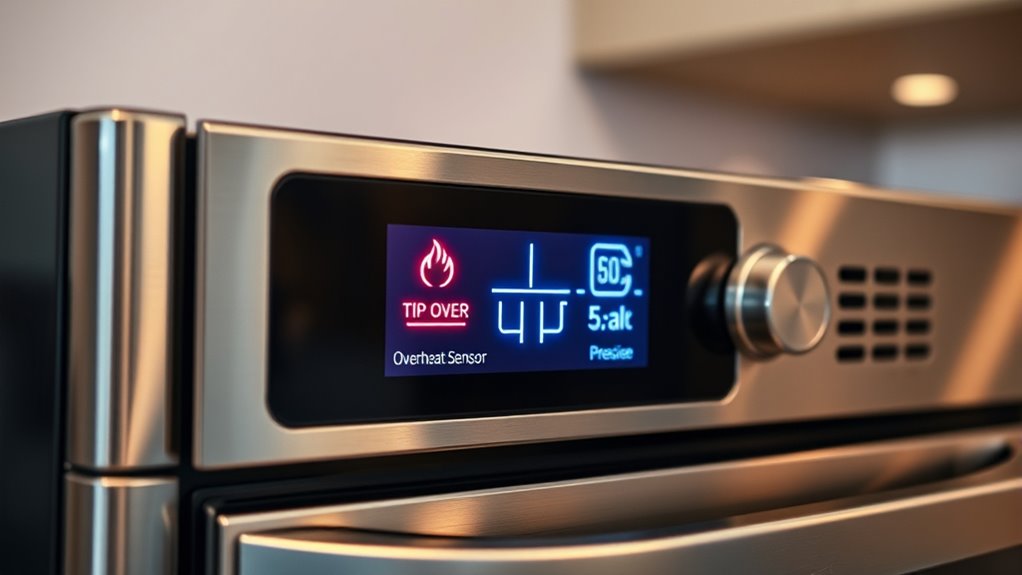
Understanding sensor alerts quickly and accurately is essential for maintaining safety and preventing potential issues. To do this effectively, pay attention to proper sensor placement; it guarantees alerts are reliable and relevant. Misplaced sensors can lead to false alarms or missed warnings, so position them according to manufacturer guidelines. Additionally, take advantage of alert customization options if available—adjust sensitivity settings to suit your environment and reduce unnecessary alerts. When an alert occurs, don’t ignore it; investigate immediately to determine if it’s a true hazard or a false alarm caused by improper sensor placement or settings. Regularly review and update your sensor configurations to adapt to changes in your setup or environment, making certain you respond swiftly and appropriately to every alert.
Frequently Asked Questions
How Often Should Sensors Be Tested for Optimal Performance?
You should test your sensors regularly, ideally every 3 to 6 months, to guarantee peak performance. Consistent testing intervals help identify calibration issues early, preventing malfunctions. During testing, verify that sensors respond accurately and reset properly. Regular sensor calibration is essential for safety and compliance. By sticking to these intervals, you maintain reliable protection and reduce the risk of false alarms or missed detections.
Are There Industry Certifications That Validate Sensor Compliance?
Yes, industry certifications verify sensor compliance. You should look for certifications like UL, CSA, or IEC, which follow strict industry standards and certification processes. These ensure your sensors meet safety and performance requirements. By choosing sensors with reputable certifications, you can be confident they adhere to the necessary standards, helping you avoid compliance issues and ensuring reliable operation. Always verify certification labels before purchasing or installing sensors.
What Are the Costs Associated With Upgrading Sensor Systems?
Unexpectedly, upgrading sensor systems can cost between a few hundred to several thousand dollars, depending on your setup. You’ll need to budget for sensor installation, which involves professional labor, and anticipate ongoing maintenance costs to keep everything functioning smoothly. These expenses vary based on the complexity of your system and the quality of sensors chosen. Planning ahead guarantees you’re prepared for both initial investment and long-term upkeep.
How Do Sensor Codes Vary Across Different Appliance Types?
Sensor codes vary across appliance types because calibration standards differ based on their function and safety requirements. You’ll find that code standardization helps guarantee consistent safety features, but calibration specifics can change depending on whether it’s a stove, heater, or other device. To stay compliant, you need to understand how these codes adapt to each appliance, ensuring proper installation and operation for safety and efficiency.
Can Sensor Failures Be Easily Diagnosed Without Professional Help?
Did you know that nearly 60% of sensor failures can be diagnosed with simple DIY troubleshooting? You can often identify sensor issues by checking for visible damage or dirt. Try cleaning the sensors first; many problems stem from dust or debris. If the appliance still malfunctions, professional help is recommended. This approach saves you time and money while ensuring your appliance functions safely and correctly.
Conclusion
By understanding the myths, mastering the meanings, and maintaining meticulous monitoring, you’ll minimize mishaps and maximize safety. Recognize the real risks, respond promptly, and stay compliant with current standards. Staying savvy about sensor signals safeguards your space and supports safety’s steadfast stance. Remember, reliable regulation, responsive action, and regular review reinforce your readiness, reducing risk and reinforcing reassurance. Stay smart, stay safe, and keep sensors secure for a safer, smarter space.


